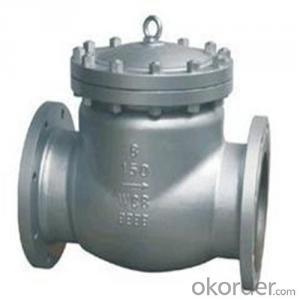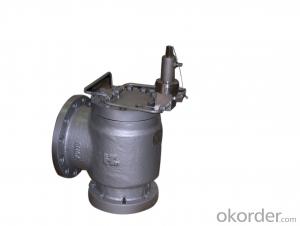High Performance WC6 Pressure Safety Valve
- Loading Port:
- China Main Port
- Payment Terms:
- TT OR LC
- Min Order Qty:
- -
- Supply Capability:
- -
OKorder Service Pledge
OKorder Financial Service
You Might Also Like
Application:
A pressure relief valve (PRV) is a safety device that relieves overpressure in a vessel or system. When the pressure of vessel or system increased beyond the specified design pressure or maximum allowable working pressure, PRV will be opened automaticly to relief the overpressure for proteding the vessel or system. The PRV will be closed if the pressure reached specified design pressure so that to ensure the normal operation and protect the vessel or system.
Our Pressure Relief Valve has been designed and manuractured according to following Standard:
♦ ISO 4123-1 Safety Devices for Portection Against Excessve Pressure
♦ API STD 526 Flanged Steel Pressure Relief Valves
♦ API STD 527 Seat Tightness of Pressure Relief Valves
♦ ASME Boiler and Pressure Vessel Code Section VIII Division 1, Rules for Construction of Pressure Vessels
Peformance:
♦ Type: Conventional, Bellows
♦ Size:1" D 2"- 8" T 10"
♦ Class:150lb~2500lb
♦ Temperature:-268~+538°C
♦ Fluid: Gas, Steam, and Liquid
♦ Material: Carbon steel, Stainless steel, Alloy steel
♦ The allowable tolerance of the set pressure: ≤±3%
♦ Overpressure: ≤10%(gas)/≤20%(liquid)
♦ Blowdown: ≤10%(gas)/≤20%(liquid)
♦ Tightness: conforms to API STD 527
Features:
♦The solid nozzle is screwed into the body, which makes the maintenance easy.
♦ The shape of the disc holder has been designed to enhance the effect of the fluid thrust for an instant lift of the disc.
♦ Blowdown control is provided with adjustable nuzzle ring only.
♦ The adequate terials and clearance between disc holder and guide , spindle and adjusting screw assures disc to lift successfully.
♦ The surface of both the disc and the nozzle seat are deposited with Stellite. Excellent flatness and surface finish of the seating surfaces by precision machining and lapping assure pressure relief valve to have high degree of seat tightness and long using life.
♦ The bellows of balanced bellows pressure relief valves can not only avoid and effect of variable back pressure in the system , but also protect spring and other trim components from corrosive media.
♦ Materials are chosen carefully , and the manufacture of the spring and the bellows has strict technological process. Each of them is tested and checked strictly.
- Q: This is in continuation to a question I posted earlier today.....In trying to remove the shut-off valve (that is for a dishwasher hookup) from the main hot water line under the kitchen sink, it just turns and turns and turns in the same spot w/out showing any threading.How to I get this removed so that I can either replace it or put a stopper on it so it will quit leaking?
- It sounds like a compression fitting.Use two wrench's. Hold the bottom nut with one then turn the valve with the other. If this doesn't do it then use a tubing cutter below the valve (assuming the line is copper) and cut off the old valve and put a new compression valve on.
- Q: How would your car run if u did not have one on it? Do u really need to have a pcv valve? I have a 1994 Ford Econoline
- PCV Positive CrankCase Ventilation, its designed to vent out the gases that leak past the piston into the crankcase. The valve is more for pollution reduction as the vented gases are recirculated back in for combustion, So you don't need it but its nice to keep the air clean,
- Q: I just bought a brand new rain bird sprinkler valve with flow control and when I turn the valve on automatically or manually it makes a loud sound that resembles a muted horn and when I close it, it makes the same sound but thumps at the end. Is this normal? Or do I need to get a new valve?
- It could be the solenoid. It could be actuating very slowly and hammering when it tries to shut off. The solenoids are only $5 or $6. Not a significant expense. I just had to replace an entire valve. Not costly but a good size hole while I was working on it.
- Q: Com wires attached to com and all individual valve wires are attached. The valves work manually( turn on by hand), I open the valve to allow the box to take over and the sprinklers run. Is this just residual water in the lines??
- I would test the leads inside the control box first... You will have to run the controls manually to troubleshoot the problem. Get a voltage meter to test for the 24 volts at the transformer connections inside the box... If you do not have the 24 volts then the problem will be the transformer. If you have the correct voltage from the transformer then you can test each of the station terminals to common. Test through each station to see if you have 24 volts at each station terminal, but you may have to remove the wires off to test. If you do not have power coming from each station… then the problem will be the rain bird control. The next step would be testing the wires… If you reconnect the wires… test just prior at each valve location to see if you have the 24 volts between the common and each station wire… if you can prove out that there is 24 volts at this location then you’re down to the final testing. Reconnect the valves – one side to the common and the other to each station wire… Getting the power (24v) to the valve should have cleared your problem. Good Luck… Running the valves manually will not affect the operation of the rainbird control... but with my rainbird valves.. you can shut off the valves completely and disable the electrical controls of the valve... make sure that you have not closed the valve off manually preventing the electrical side... a problem with rainbird controls. This does not have anything to do with residual water in the lines... I would test this side first before you get into the electrical side... could save you a lot of time.
- Q: Holding my right hand up, I am a newbie :) any help is greatly appreciated.a) Comparing the shape of the valve to a golf tee, what is the correct name for the thinnest section of the valve(the part of the golf tee that goes into the ground)b) What is the correct name for the widest section of the valve(the part of the golf tee that the ball is placed on.c) The cylinder that the valve moves up and down in, is it just called the valve cylinder?d) In the valve cylinder?, how does the widest part of the valve keeps things sealed. Does it use a ring(simmilar to pistons) or is it some type of gasket material or is it just zero clearance metal to metal.e) The section of the (valve cylinder?) that is above the seal point or basicaly where the valve spring and the thinnest part of the valve is, does oil flow through here?f) Do (valve cylinders?) generate enough heat to warrant the need for coolant?Newbie City, I know. Any help is GREATLY appreciated.TY
- a) The very end is the tip. Below that are grooves that the keepers lock into. This is actually the thinnest part. Below that is the rest of the stem. The general name for the largest part in total is the valve head. b) Surface sounds right. Hadn't really thought about it before. LOL c) Valve Guide. These can either be just a plain hole in the cylinder head material, or often they have bronze inserts. Plain Guides are often repaired by a process called knurling. d) Valves seal to the head by grinding each at the same angle, (usually 45 degrees) and then they are lapped which is where an abrasive compound is placed in between, and the valve is rotated. This matches the surfaces more closely yet. The parts that seal are called the valve face and the seat which is actually a separate part that is inserted into the head, and can be replaced. e) Oil is supplied to that general area, by either holes in pushrods that lubricate the rocker arm, or in the case of rockers mounted to a shaft, through the shaft. In the first case, oil is supplied by the hydraulic lifters. In the latter, the shaft pedestals are drilled for oil passages. In both cases, oil is present in the area, but is not applied directly to the valves. In fact, the job of the valve stem seal is to keep too much oil from getting in the guides. f) Usually the coolant flowing through the heads is enough to carry away the heat, although some hi-performance engines employ techniques such as hollow exhaust valves filled with sodium. Most normal valves are solid.
- Q: I have a 78 honda hawkii 400 or cb400TII and I need to know what the valve gaping needs to be set to
- Honda Hawk 400
- Q: what to use to inflate self sealing tube with the presta valve?
- You okorder /
- Q: Is there a difference between the atrioventricular valves in the right side versus the left side of the heart?Is there a different between the pulmonary valves?
- There are two types of valves: cuspid valves between chambers which are anchored by chordae tendonae in the ventricles and semilunar valves found in the vessels leaving the heart. The left atrium and left ventricle are separated by the bicuspid/mitral valve. The right atrium and right ventricle are separated by the tricuspid valve. Semilunar valves are found in the pulmonary artery and aorta leaving the left right and left ventricles, respectively.
- Q: i wanna know the role of TOP ENTRY in this definition it's difference with side entry valve.
- The ball and seat components enter from the top for top entry ball valves, while the ball and seats enter from the side for side entry ball valves. The top entry features online maintenance without dismounting the valves from the pipes.
- Q: The water inlet valve on my Kenmore washer leaks. Is there an easy way to replace it? Last time it broke they charged me over $100 to fix it.
- see if you can find a manuel on it also try tracing the wires that go to the valve and back track from there. there is also water level switches and tempture switches that might be messed up
Send your message to us
High Performance WC6 Pressure Safety Valve
- Loading Port:
- China Main Port
- Payment Terms:
- TT OR LC
- Min Order Qty:
- -
- Supply Capability:
- -
OKorder Service Pledge
OKorder Financial Service
Similar products
Hot products
Hot Searches
Related keywords
























